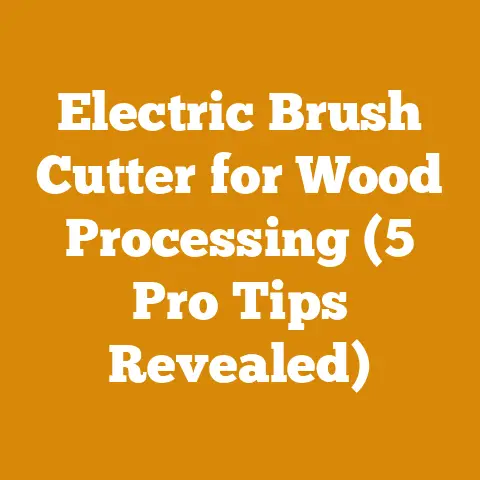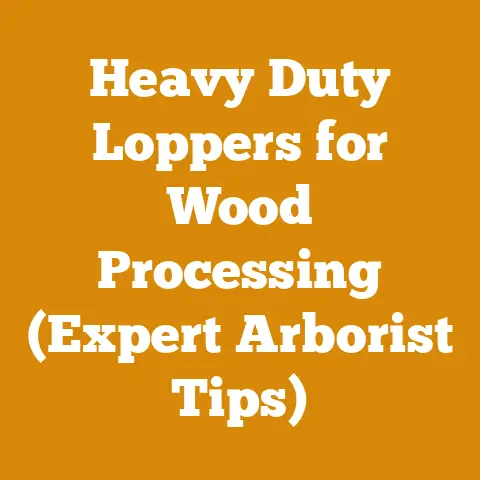SBK Stump Killer Tips for Buckthorn (5 Pro Woodcutting Hacks)
Are you tired of battling buckthorn, watching it relentlessly take over your property? Let me tell you, I know the feeling. I’ve spent years wrestling with invasive species, and buckthorn, with its sneaky resilience, has been a particularly persistent foe. Over time, I’ve developed a few “hacks,” as some call them, to give you the upper hand. This isn’t just about cutting; it’s about killing the stump to prevent regrowth. So, let’s dive into how to effectively eradicate buckthorn using the SBK stump killer method and some pro woodcutting techniques I’ve picked up along the way.
Understanding the Buckthorn Beast
Before I grab my chainsaw and start swinging, I need to understand my enemy. Buckthorn is an invasive shrub or small tree, originating from Europe and Asia. It’s notorious for its aggressive growth, outcompeting native plants and disrupting ecosystems. Two main types plague North America: common buckthorn ( Rhamnus cathartica) and glossy buckthorn (Frangula alnus).
Identifying buckthorn is crucial. Look for:
- Leaves: Oval-shaped with finely toothed edges (common buckthorn) or smooth edges (glossy buckthorn).
- Thorns: Common buckthorn has thorns at the tips of twigs.
- Berries: Small, black berries that persist into winter.
- Bark: Grayish-brown with distinctive orange inner bark.
Buckthorn is a master of regeneration. If you simply cut it down, it will vigorously resprout from the stump. That’s where the SBK stump killer comes in. We’re aiming for a systemic kill, meaning the herbicide needs to be absorbed into the plant’s vascular system to reach the roots.
The SBK Stump Killer Method: A Step-by-Step Guide
SBK, or Stump and Brush Killer, is a selective herbicide containing triclopyr. It’s effective against woody plants like buckthorn but generally safe for grasses. However, always read and follow the manufacturer’s instructions carefully.
1. Gathering Your Arsenal: Tools and Safety Gear
Before you even think about firing up your chainsaw, gather your gear. Safety is paramount. I’ve seen too many avoidable accidents in my years of working with wood.
- Chainsaw: I prefer a mid-sized chainsaw for buckthorn removal. Something with a 16-18 inch bar is usually sufficient. Make sure it’s well-maintained, with a sharp chain. Dull chains are dangerous.
- Personal Protective Equipment (PPE): This is non-negotiable. At a minimum, you need:
- Chainsaw chaps: These protect your legs from accidental cuts.
- Eye protection: Safety glasses or a face shield are essential.
- Hearing protection: Chainsaws are loud. Use earplugs or earmuffs.
- Gloves: Protect your hands and improve your grip.
- Steel-toed boots: Prevent foot injuries.
- Helmet: Especially important if you’re working in areas with falling branches.
- SBK Stump Killer: Choose a product specifically labeled for stump treatment.
- Applicator: A paintbrush, spray bottle, or garden sprayer. I usually opt for a paintbrush for precise application.
- Measuring cup or syringe: For accurate mixing of the herbicide.
- Mixing container: A plastic bucket or container.
- Marking dye (optional): To mark treated stumps.
- First-aid kit: Accidents happen. Be prepared.
2. Timing is Everything: When to Strike
The best time to apply SBK stump killer is in late summer or early fall, after the buckthorn has finished flowering and is actively transporting nutrients down to its roots. This is when the herbicide will be most effectively absorbed.
I’ve found that applying SBK in late September or early October, after a good rain, yields the best results. The rain helps the herbicide penetrate the bark.
3. The Cut: Making the Right Move
The cut is crucial for effective herbicide application. Don’t just hack away at the buckthorn. Aim for a clean, horizontal cut as close to the ground as possible.
- Clear the area: Remove any debris, brush, or obstacles around the base of the buckthorn.
- Make the cut: Use your chainsaw to make a clean, level cut through the stem. Avoid angled cuts, as they won’t hold the herbicide as well.
- Cut larger stems: For buckthorn stems larger than 4 inches in diameter, I recommend making multiple cuts around the circumference of the stem, leaving a thin “lip” to hold the herbicide. This increases the surface area for absorption.
4. Mixing the Magic Potion: Preparing the Herbicide
Follow the manufacturer’s instructions for mixing the SBK stump killer. The concentration will vary depending on the product. I usually use a concentration of 25-50% SBK in water for stump treatments.
- Measure accurately: Use a measuring cup or syringe to ensure you’re using the correct amount of herbicide.
- Mix thoroughly: Stir the mixture well to ensure the herbicide is evenly distributed.
- Use clean water: Avoid using water that is heavily mineralized or contains sediment.
5. Application: Saturating the Stump
Apply the SBK mixture to the freshly cut stump immediately after cutting. The sooner you apply it, the better the absorption.
- Saturate the cambium layer: The cambium is the thin layer of actively growing tissue just beneath the bark. It’s responsible for transporting water and nutrients throughout the plant. Make sure to thoroughly saturate this layer with the herbicide.
- Apply to the entire cut surface: Cover the entire cut surface of the stump with the SBK mixture.
- Don’t over-apply: You don’t need to flood the area. Just make sure the stump is thoroughly saturated.
- Mark the treated stumps: Use marking dye or flagging tape to mark the treated stumps. This will help you keep track of which ones you’ve already treated.
6. Monitoring and Follow-Up: The Waiting Game
After applying the SBK stump killer, monitor the treated stumps for signs of regrowth. It may take several weeks or even months for the herbicide to completely kill the buckthorn.
- Check for sprouts: Look for new shoots emerging from the stump or roots.
- Reapply if necessary: If you see any signs of regrowth, reapply the SBK stump killer to the new sprouts.
- Dispose of debris properly: Once the buckthorn is dead, you can dispose of the debris by burning it (where permitted), chipping it, or composting it.
Pro Woodcutting Hacks for Buckthorn Removal
Over the years, I’ve developed a few woodcutting “hacks” that make buckthorn removal easier and more efficient.
Hack #1: The “Hinge Cut” for Leaning Buckthorn
When dealing with buckthorn that’s leaning precariously, the hinge cut is your friend. This technique allows you to control the direction of the fall, preventing damage to nearby trees or structures.
- Assess the lean: Determine the direction the buckthorn is naturally leaning.
- Make the notch: On the side of the buckthorn facing the direction you want it to fall, make a notch that’s about one-third of the diameter of the stem. The notch should have a 45-degree angle at the top and a horizontal cut at the bottom.
- Make the back cut: On the opposite side of the stem, make a back cut that’s slightly higher than the bottom of the notch. Leave a “hinge” of wood between the back cut and the notch.
- Push it over: Use a felling lever or wedge to push the buckthorn over in the desired direction. The hinge will control the fall.
Hack #2: The “Bore Cut” for Thick Buckthorn
When dealing with buckthorn that’s too thick to cut through in one pass, the bore cut is a safe and effective technique.
- Make a pilot hole: Use the tip of your chainsaw to bore a small hole through the center of the stem.
- Widen the hole: Gradually widen the hole by moving the chainsaw back and forth.
- Cut outwards: Once the hole is large enough, start cutting outwards towards the bark.
- Leave a hinge: Leave a small hinge of wood on one side of the stem to control the fall.
Hack #3: The “Brush Pile Burn” for Efficient Disposal
Burning brush piles is an efficient way to dispose of buckthorn debris, but it’s important to do it safely and responsibly.
- Check local regulations: Make sure burning is permitted in your area and obtain any necessary permits.
- Choose a safe location: Select a location that’s clear of trees, brush, and other flammable materials.
- Build a stable pile: Stack the buckthorn debris in a stable pile that won’t collapse.
- Have water nearby: Keep a hose or water source nearby in case the fire gets out of control.
- Never leave the fire unattended: Monitor the fire closely and make sure it’s completely extinguished before leaving.
Hack #4: The “Chipping and Mulching” Method for Soil Enrichment
If burning isn’t an option, chipping and mulching buckthorn debris is a great way to enrich your soil and suppress weed growth.
- Rent a chipper: Rent a wood chipper from a local rental company.
- Chip the debris: Feed the buckthorn debris into the chipper.
- Spread the mulch: Spread the resulting mulch around trees, shrubs, or garden beds.
- Compost the mulch: Alternatively, you can compost the mulch before using it in your garden.
Hack #5: The “Stump Grinding” Technique for Complete Removal
For a truly thorough buckthorn removal, consider stump grinding. This technique completely removes the stump and roots, preventing any chance of regrowth.
- Rent a stump grinder: Rent a stump grinder from a local rental company.
- Grind the stump: Position the stump grinder over the stump and grind it down to below ground level.
- Fill the hole: Fill the resulting hole with soil or compost.
Beyond the Stump: Long-Term Buckthorn Management
Removing buckthorn is just the first step. Long-term management is essential to prevent it from returning.
- Monitor regularly: Regularly inspect your property for new buckthorn seedlings.
- Remove seedlings promptly: Pull or dig up any new seedlings as soon as you see them.
- Promote native plants: Encourage the growth of native plants to outcompete buckthorn.
- Consider biological control: Research biological control options, such as grazing animals or fungal pathogens, that can help control buckthorn populations.
Chainsaw Maintenance: Keeping Your Tool Sharp and Ready
A well-maintained chainsaw is a safe and efficient chainsaw. I can’t stress this enough. Regular maintenance will prolong the life of your tool and prevent accidents.
- Sharpen the chain regularly: A dull chain is more likely to kick back and cause injury. Sharpen the chain every time you refuel or when you notice it’s not cutting as efficiently.
- Clean the air filter: A dirty air filter restricts airflow and reduces engine performance. Clean the air filter regularly, especially when working in dusty conditions.
- Check the spark plug: A fouled spark plug can cause starting problems and poor engine performance. Clean or replace the spark plug as needed.
- Lubricate the bar and chain: Proper lubrication reduces friction and wear on the bar and chain. Use a high-quality bar and chain oil.
- Inspect the chainsaw regularly: Check for loose bolts, cracked housings, and other signs of damage. Repair or replace any damaged parts.
- Store the chainsaw properly: Store the chainsaw in a dry, safe place when not in use.
Understanding Wood Types and Their Properties
Knowing the different types of wood and their properties is essential for efficient wood processing and firewood preparation.
- Hardwoods: Hardwoods are generally denser and heavier than softwoods. They burn longer and produce more heat. Examples include oak, maple, ash, and birch.
- Softwoods: Softwoods are generally less dense and lighter than hardwoods. They burn faster and produce less heat. Examples include pine, fir, spruce, and cedar.
- Moisture content: The moisture content of wood affects its burning properties. Dry wood burns more efficiently and produces less smoke. Aim for a moisture content of 20% or less for firewood.
- Seasoning: Seasoning is the process of drying wood to reduce its moisture content. This can be done by air-drying or kiln-drying. Air-drying typically takes 6-12 months, while kiln-drying can be done in a matter of days.
Sawmill Operations: From Log to Lumber
If you’re processing larger quantities of wood, a sawmill can be a valuable tool.
- Types of sawmills: There are several types of sawmills, including portable sawmills, band sawmills, and circular sawmills.
- Sawing patterns: Different sawing patterns can be used to maximize lumber yield and quality.
- Timber grading: Timber grading is the process of assessing the quality and value of lumber.
- Safety precautions: Sawmill operations can be dangerous. Always follow safety precautions and wear appropriate PPE.
Splitting Techniques: Making Firewood Easier
Splitting firewood can be a back-breaking task, but there are techniques that can make it easier.
- Use a good splitting axe or maul: A sharp axe or maul will make splitting easier and safer.
- Choose the right wood: Straight-grained wood is easier to split than knotty wood.
- Use a splitting wedge: A splitting wedge can be used to split tough or knotty wood.
- Consider a log splitter: A log splitter can make splitting firewood much easier and faster.
Wood Drying Processes: Achieving Optimal Moisture Content
Drying wood properly is crucial for efficient burning and reducing smoke.
- Air-drying: Air-drying is the most common method of drying firewood. Stack the wood in a well-ventilated area and allow it to dry for 6-12 months.
- Kiln-drying: Kiln-drying is a faster method of drying wood. The wood is placed in a kiln and heated to a specific temperature.
- Moisture meters: Use a moisture meter to check the moisture content of the wood.
Safety Procedures: Protecting Yourself and Others
Safety should always be your top priority when working with wood.
- Wear appropriate PPE: Always wear safety glasses, hearing protection, gloves, and steel-toed boots.
- Use caution when operating power tools: Follow the manufacturer’s instructions and never operate power tools when you’re tired or distracted.
- Be aware of your surroundings: Watch out for falling branches, uneven terrain, and other hazards.
- Have a first-aid kit on hand: Accidents happen. Be prepared.
- Never work alone: Always have someone else nearby in case of an emergency.
Common Mistakes to Avoid: Learning from Experience
I’ve made my fair share of mistakes over the years. Here are a few common ones to avoid:
- Using a dull chainsaw: A dull chainsaw is dangerous and inefficient.
- Not wearing PPE: PPE is essential for protecting yourself from injury.
- Cutting corners on safety: Safety should always be your top priority.
- Not following the manufacturer’s instructions: Always follow the manufacturer’s instructions for operating power tools and applying herbicides.
- Underestimating the power of buckthorn: Buckthorn is a resilient plant. Don’t underestimate its ability to regrow.
Actionable Metrics: Measuring Your Success
How do you know if you’re succeeding in your buckthorn removal efforts? Here are a few actionable metrics to track:
- Number of buckthorn plants removed: Keep track of how many buckthorn plants you’ve removed.
- Percentage of buckthorn regrowth: Monitor the treated stumps for signs of regrowth and calculate the percentage of stumps that require re-treatment.
- Time spent on buckthorn removal: Track the amount of time you’re spending on buckthorn removal. This will help you identify areas where you can improve efficiency.
- Cost of buckthorn removal: Calculate the cost of buckthorn removal, including the cost of herbicides, tools, and labor.
- Improvement in native plant cover: Monitor the growth of native plants in the areas where you’ve removed buckthorn.
Conclusion: Winning the War Against Buckthorn
Battling buckthorn is a marathon, not a sprint. It requires persistence, dedication, and the right tools and techniques. By following the steps outlined in this guide, you can effectively eradicate buckthorn from your property and restore the health of your ecosystem. Remember to prioritize safety, maintain your tools, and monitor your progress. With a little effort, you can win the war against buckthorn and create a thriving, native landscape. It’s a rewarding experience, trust me.
Now, grab your chainsaw, gear up, and get to work! Your property will thank you for it.






